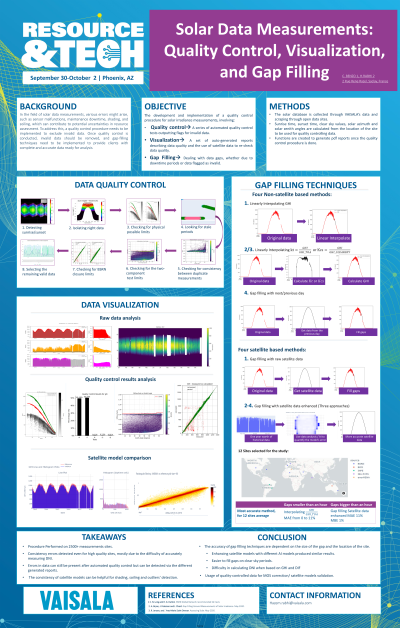Back

Summary, Solar data measurements: Visualization, quality control and gap filling
Tuesday, October 1, 2024
5:00 PM – 6:00 PM MST
Location: Regency D


Cristina Benzo
Data Science and Application Engineer
Vaisala
Saclay, Ile-de-France, France
Poster Presenter(s)
Poster Description: Many factors can significantly affect solar radiation measurements including shading, pyranometer uncertainties, data preprocessing errors, and more, thus potentially severely impacting solar resource assessments. This project proposes a holistic quality control methodology that eliminates poor quality data and dynamic gap-filling methods.
The data is firstly visualized to assess quality/quantity of solar radiation. These graphs detect periods of missing data, time shifts, clouds, and shading. Data is additionally compared with satellite models as the model performance is validated on high-quality reference data; any anomalies that arise from this comparison can assess the quality of the measurement.
The quality control algorithm that is then applied depending on the availability of the measured solar components. These methods include checks of max/min physical limits, extremely rare limits, consistency, night-time detection, and more. Data is flagged if the number of invalid data points within a given time span is significantly impactful. Depending on the distribution of the remaining valid data, this research proposes several techniques such as interpolation, machine learning and satellite data to close data gaps.
The results of this study present a robust automated quality control method based on research studies, satellite data, and ground-based data, followed by an advanced gap filling algorithm data for accurate and continuous analysis.
The data is firstly visualized to assess quality/quantity of solar radiation. These graphs detect periods of missing data, time shifts, clouds, and shading. Data is additionally compared with satellite models as the model performance is validated on high-quality reference data; any anomalies that arise from this comparison can assess the quality of the measurement.
The quality control algorithm that is then applied depending on the availability of the measured solar components. These methods include checks of max/min physical limits, extremely rare limits, consistency, night-time detection, and more. Data is flagged if the number of invalid data points within a given time span is significantly impactful. Depending on the distribution of the remaining valid data, this research proposes several techniques such as interpolation, machine learning and satellite data to close data gaps.
The results of this study present a robust automated quality control method based on research studies, satellite data, and ground-based data, followed by an advanced gap filling algorithm data for accurate and continuous analysis.
